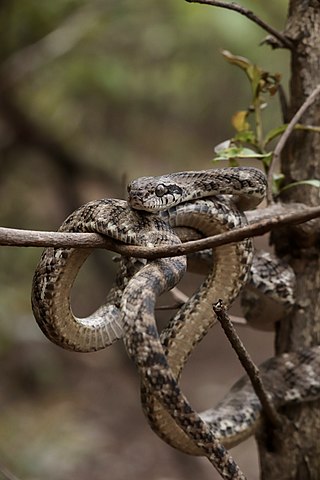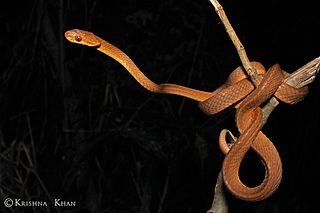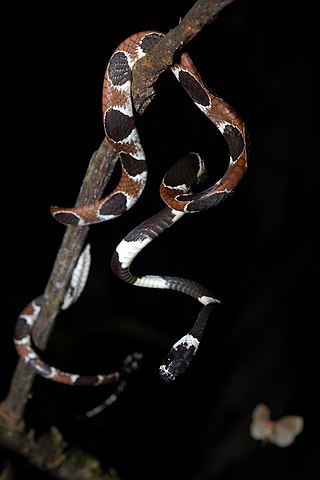
Boiga forsteni, also known commonly as Forsten's cat snake, is a species of mildly venomous rear-fanged snake in the family Colubridae. The species is endemic to South Asia.

Boiga ochracea, commonly called the tawny cat snake, is a species of rear-fanged snake in the family Colubridae. The species is endemic to South Asia.
Ptyas nigromarginata, commonly known as the green rat snake or black-bordered rat snake, is a species of snake in the family Colubridae. The species is endemic to Asia.

Boiga drapiezii, commonly known as Drapiez's cat snake and the white-spotted cat snake, is a species of long and slender rear-fanged snake in the family Colubridae. The species is native to Maritime Southeast Asia and is common throughout its range.

Dipsas is a genus of nonvenomous New World snakes in the subfamily Dipsadinae of the family Colubridae. The genus Sibynomorphus has been moved here. Species of the genus Dipsas are known as snail-eaters.

The graceful snail-eater, is a non-venomous snake found in the northern part of South America . No subspecies are currently recognized.

Catesby's snail-eater, also commonly known as Catesby's snail sucker, is a nocturnal species of nonvenomous snake in the family Colubridae. The species is native to northern South America.
Dipsas pakaraima is an arboreal snake of the family Dipsadidae. It has been placed in the Dipsas temporalis group. It is native to medium and higher elevations in west-central Guyana. It has been collected in Kaieteur National Park and Mount Ayanganna. Its food probably consists of snails and slugs.

Dipsadinae is a large subfamily of colubroid snakes, sometimes referred to as a family (Dipsadidae). They are found in most of the Americas, including the West Indies, and are most diverse in South America. There are more than 700 species.
Dipsas pratti, known commonly as Pratt's snail-eater, is a species of arboreal snake in the subfamily Dipsadinae of the family Colubridae. The species is endemic to northern South America.

Sibon longifrenis, Stejneger's snail sucker or lichen-colored snail sucker, is a species of snake in the family Colubridae. It is found in Panama, Costa Rica, Honduras and Nicaragua.
Telescopus rhinopoma is a species of rear-fanged mildly venomous snake in the family Colubridae. The species is found in the Middle East (Iran), Afghanistan, Pakistan desert areas like Bahawalpur, and Central Asia (Turkmenistan).

Toxicodryas blandingii, commonly known as Blanding's cat snake and Blanding's tree snake, is a species of rear-fanged venomous snake of the family Colubridae. The species is endemic to Sub-Saharan Africa.
Ernest Edward Williams was an American herpetologist. He coined the term ecomorph based on his research on anoles.
Dryophylax chaquensis is a species of snake in the family Colubridae. The species is endemic to Brazil.
Dipsas gaigeae, also known commonly as Gaige's thirst snail-eater, Gaige's thirst snake, and zicatlinán in Mexican Spanish, is a species of non-venomous snake in the family Colubridae. The species is endemic to Mexico.
Erythrolamprus williamsi, Williams's ground snake, is a species of snake in the family Colubridae. The species is found in Venezuela.
Ptyas dipsas, the Sulawesi black racer, is a species of snake of the family Colubridae.
Maria Nelly Carrillo Tarazona de Espinoza was a Peruvian herpetologist known as Nelly Carrillo Espinoza.







